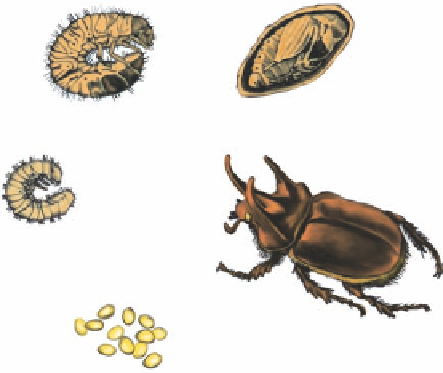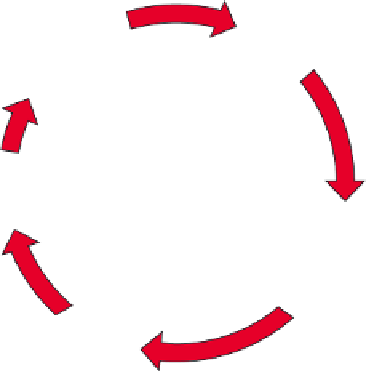Environmental Engineering Reference
In-Depth Information
nationwide education program to help farmers switch
to IPM. The results were dramatic: Between 1987 and
1992, pesticide use dropped by 65%, rice production
rose by 15%, and more than 250,000 farmers were
trained in IPM techniques. Sweden and Denmark have
used IPM to cut their pesticide use in half.
The experiences of these and other countries show
that a well-designed IPM program can reduce pesti-
cide use and pest control costs by at least half, cut pre-
harvest pest-induced crop losses by half, and improve
crop yields. It can also reduce inputs of fertilizer and
irrigation water, and slow the development of genetic
resistance because pests are assaulted less often and
with lower doses of pesticides. IPM is an important
form of
pollution prevention
MH
Pupa
MH
MH
JH
Larva
Black
MH
Eggs
that reduces risks to
wildlife and human health.
Despite its promise, IPM—like any other form of
pest control—has some disadvantages. It requires ex-
pert knowledge about each pest situation and acts
more slowly than conventional pesticides. Methods
developed for a crop in one area might not apply to ar-
eas with even slightly different growing conditions.
Initial costs may be higher, although long-term costs
typically are lower than those of using conventional
pesticides.
Widespread use of IPM is hindered by govern-
ment subsidies for conventional chemical pesticides
and opposition by pesticide manufacturers, whose
sales would drop sharply. There is also a lack of ex-
perts to help farmers shift to IPM.
A 1996 study by the National Academy of Sciences
recommended that the United States shift from chemi-
cally based approaches to ecologically based pest man-
agement approaches. Within 5-10 years, such a shift
could cut U.S. pesticide use in half, as it has in several
other countries.
Agrowing number of scientists urge the USDA
to use three strategies to promote IPM in the United
States:
JH
JH
Figure 10-30
Science:
for normal insect growth, development,
and reproduction to occur, certain juvenile hormones (JH) and
molting hormones (MH) must be present at genetically deter-
mined stages in the insect's life cycle. If applied at the proper
time, synthetic hormones disrupt the life cycles of insect pests
and help control their populations.
Science: Integrated Pest Management
An ecological approach to pest control uses an
integrated mix of cultivation and biological methods,
and small amounts of selected chemical pesticides as a
last resort.
Many pest control experts and farmers believe the best
way to control crop pests is a carefully designed
in-
tegrated pest management (IPM)
program. In this ap-
proach, each crop and its pests are evaluated as parts
of an ecological system. Then farmers develop a con-
trol program that includes cultivation, biological, and
chemical methods applied in the proper sequence and
with the proper timing.
The overall aim of IPM is not to eradicate pest
populations but rather to reduce crop damage to an
economically tolerable level. Fields are monitored care-
fully. When an economically damaging level of pests is
reached, farmers first use biological methods (natural
predators, parasites, and disease organisms) and culti-
vation controls, including vacuuming up harmful
bugs. Small amounts of insecticides—mostly based on
natural insecticides produced by plants—are applied
only as a last resort. Also, different chemicals are used
to slow the development of genetic resistance and to
avoid killing predators of pest species.
In 1986, the Indonesian government banned 57 of
the 66 pesticides used on rice, and phased out pesti-
cide subsidies over a 2-year period. It also launched a
■
Add a 2% sales tax on pesticides and use the
revenue to fund IPM research and education.
■
Set up a federally supported IPM demonstration
project on at least one farm in every county.
■
Train USDA field personnel and county farm
agents in IPM so they can help farmers use this
alternative.
The pesticide industry has successfully opposed such
measures.
x
H
OW
W
OULD
Y
OU
V
OTE
?
Should governments heavily
subsidize a switch to integrated pest management? Cast your
vote online at http://biology.brookscole.com/miller11.















